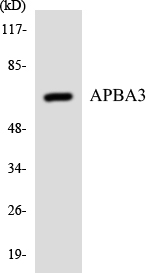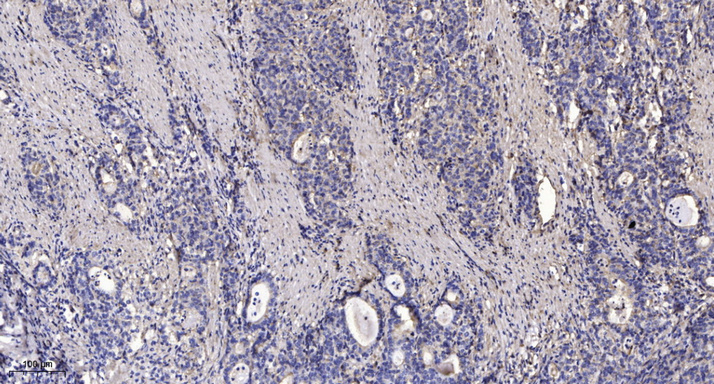X11γ Polyclonal Antibody
- Catalog No.:YT4911
- Applications:WB;IHC;IF;ELISA
- Reactivity:Human;Rat;Mouse;
- Target:
- X11γ
- Gene Name:
- APBA3
- Protein Name:
- Amyloid beta A4 precursor protein-binding family A member 3
- Human Gene Id:
- 9546
- Human Swiss Prot No:
- O96018
- Mouse Swiss Prot No:
- O88888
- Immunogen:
- The antiserum was produced against synthesized peptide derived from human APBA3. AA range:361-410
- Specificity:
- X11γ Polyclonal Antibody detects endogenous levels of X11γ protein.
- Formulation:
- Liquid in PBS containing 50% glycerol, 0.5% BSA and 0.02% sodium azide.
- Source:
- Polyclonal, Rabbit,IgG
- Dilution:
- WB 1:500 - 1:2000. IHC 1:100 - 1:300. ELISA: 1:40000.. IF 1:50-200
- Purification:
- The antibody was affinity-purified from rabbit antiserum by affinity-chromatography using epitope-specific immunogen.
- Concentration:
- 1 mg/ml
- Storage Stability:
- -15°C to -25°C/1 year(Do not lower than -25°C)
- Other Name:
- APBA3;MINT3;X11L2;Amyloid beta A4 precursor protein-binding family A member 3;Adapter protein X11gamma;Neuron-specific X11L2 protein;Neuronal Munc18-1-interacting protein 3;Mint-3
- Observed Band(KD):
- 61kD
- Background:
- amyloid beta precursor protein binding family A member 3(APBA3) Homo sapiens The protein encoded by this gene is a member of the X11 protein family. It is an adapter protein that interacts with the Alzheimer's disease amyloid precursor protein. This gene product is believed to be involved in signal transduction processes. This gene is a candidate gene for Alzheimer's disease. [provided by RefSeq, Jul 2008],
- Function:
- domain:Composed of an N-terminal domain, a middle phosphotyrosine-binding domain (PID/PTB) that mediates binding with the cytoplasmic domain of the beta-amyloid precursor protein, and two C-terminal PDZ domains thought to attach proteins to the plasma membrane.,function:May modulate processing of the beta-amyloid precursor protein (APP) and hence formation of beta-APP.,similarity:Contains 1 PDZ (DHR) domain.,similarity:Contains 1 PID domain.,similarity:Contains 2 PDZ (DHR) domains.,subunit:Binds to the cytoplasmic domain of amyloid protein (APP) in vivo.,tissue specificity:Expressed in all the tissues examined with lower levels in brain and testis.,
- Subcellular Location:
- Cytoplasm, perinuclear region .
- Expression:
- Expressed in all tissues examined with lower levels in brain and testis.
- June 19-2018
- WESTERN IMMUNOBLOTTING PROTOCOL
- June 19-2018
- IMMUNOHISTOCHEMISTRY-PARAFFIN PROTOCOL
- June 19-2018
- IMMUNOFLUORESCENCE PROTOCOL
- September 08-2020
- FLOW-CYTOMEYRT-PROTOCOL
- May 20-2022
- Cell-Based ELISA│解您多样本WB检测之困扰
- July 13-2018
- CELL-BASED-ELISA-PROTOCOL-FOR-ACETYL-PROTEIN
- July 13-2018
- CELL-BASED-ELISA-PROTOCOL-FOR-PHOSPHO-PROTEIN
- July 13-2018
- Antibody-FAQs
- Products Images

- Western blot analysis of lysates from HUVEC cells, using APBA3 Antibody. The lane on the right is blocked with the synthesized peptide.

- Western blot analysis of the lysates from COLO205 cells using APBA3 antibody.

- Immunohistochemical analysis of paraffin-embedded human Gastric adenocarcinoma. 1, Antibody was diluted at 1:200(4° overnight). 2, Tris-EDTA,pH9.0 was used for antigen retrieval. 3,Secondary antibody was diluted at 1:200(room temperature, 45min).



